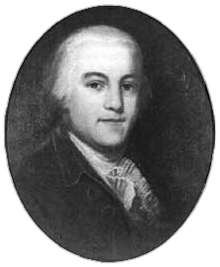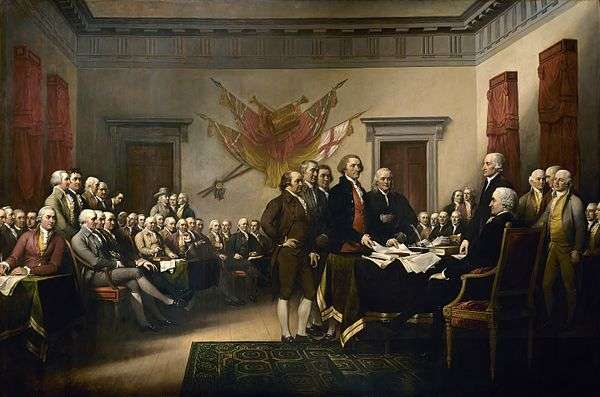Edward Rutledge
| Edward Rutledge | |
|---|---|
 | |
| 39th Governor of South Carolina | |
|
In office December 18, 1798 – January 23, 1800 | |
| Lieutenant | John Drayton |
| Preceded by | Charles Pinckney |
| Succeeded by | John Drayton |
| Member of the South Carolina Senate from Charleston | |
|
In office November 28, 1796 – December 6, 1798 | |
| Member of the South Carolina House of Representatives from the St. Phillip's and St. Michael's Parish | |
|
In office January 6, 1783 – November 28, 1796 | |
| Member of the South Carolina General Assembly from St. Phillip's and St. Michael's Parish | |
|
In office March 26, 1776 – October 17, 1778 | |
| Delegate from South Carolina to the Continental Congress | |
|
In office 1774 – 1776 | |
| Personal details | |
| Born |
November 23, 1749 Charleston, South Carolina, British America |
| Died |
January 23, 1800 (aged 50) Charleston, South Carolina, U.S. |
| Resting place | Saint Philip's Episcopal Church Cemetery, Charleston |
| Political party | Federalist |
| Spouse(s) |
Henrietta Middleton Mary Shubrick Eveleigh |
| Religion | Episcopal Church |
| Signature |
|
| Military service | |
| Allegiance |
|
| Service/branch | South Carolina militia |
| Years of service | 1778–1781 |
| Rank | Captain |
| Battles/wars | |
Edward Rutledge (November 23, 1749 – January 23, 1800) was an American politician, and youngest signer of the United States Declaration of Independence. He later served as the 39th Governor of South Carolina.
Early life and education
Like his eldest brother John Rutledge, Edward was born in Charleston. He was the youngest of seven children (5 sons and 2 daughters) born to Dr. John Rutledge and Sarah Hext. His father was a physician and colonist of Scots-Irish descent; his mother was born in South Carolina and was of English descent. Following his brothers John and Hugh he studied law in London at the Inns of Court. In 1772 he was admitted to the English bar (Middle Temple), and returned to Charleston to practice. He was married on March 1, 1774 to Henrietta Middleton (17 November 1750 – 22 April 1792), daughter of Henry Middleton. The couple had three children;
- Maj. Henry Middleton Rutledge (5 April 1775 – 20 January 1844)
- Edward Rutledge (20 March 1778 – 1780)
- Sarah Rutledge (1782–1855)
Rutledge had a successful law practice with his partner, Charles Cotesworth Pinckney. He became a leading citizen of Charleston, and owned more than 50 slaves.[1]
Career
American Revolution
During the American Revolution Rutledge served along with his brother John representing South Carolina in the Continental Congress. He worked to have African Americans expelled from the Continental Army.[1] Although a firm supporter of colonial rights, he (as a delegate) was instructed initially to oppose Lee's Resolution of independence; South Carolina's leaders were unsure that the time was "ripe."[2] At age 26 he was the youngest delegate to sign the Declaration of Independence.
He returned home in November 1776 to take a seat in the General Assembly. He served as a captain of artillery in the South Carolina militia, and fought at the Battle of Beaufort in 1779. In May 1780, Rutledge was captured along with his co-signers of the Declaration of Independence, Arthur Middleton and Thomas Heyward during the siege of Charleston. They were released during a prisoner exchange in July 1781.[3]

Later life and death
.jpg)
After his release he returned to the General Assembly, where he served until 1796. He was known as an active legislator and an advocate for the confiscation of Loyalist property. He served in the state senate for two years, then was elected governor in 1798.
Governor Rutledge, while attending an important meeting in Columbia, had to be sent home because of his gout. He died in Charleston before the end of his term. Some said at the time that he died from apoplexy resulting from hearing the news of George Washington's death.[1] He was buried at the Saint Philip's Episcopal Church Cemetery in Charleston.[4]
In popular culture
Rutledge was a main character in the musical play 1776, in which he sings the song "Molasses to Rum" about slavery and the triangular trade. He is depicted as the secondary antagonist in the play (to John Dickinson) in obstructing John Adams, Benjamin Franklin, and Thomas Jefferson. Rutledge was portrayed by Clifford David in the original Broadway production, and John Cullum in the 1972 film.
1776 claims that Rutledge led the opposition to an anti-slavery clause in the original draft of the Declaration. Rutledge's leadership against the clause is fictitious. According to Jefferson, the clause was opposed by South Carolina and Georgia, plus unspecified "northern brethren";[5] that is the limit of known information about opposition to the clause. Rutledge was a delegate from South Carolina, but there is no evidence in the historical record that he played any part—much less that of leader—in the opposition to the clause.[6]
In the 2008 miniseries John Adams, Rutledge was portrayed by Clancy O'Connor, where his vote for independence is portrayed as contingent not upon the removal of the clause on slavery from the Declaration, but on the condition that there would be no votes in opposition to the motion on independence, a condition which Adams assures him will be fulfilled.
In the Fox television series Sleepy Hollow, a present-day Rutledge descendant (who also happens to be a Freemason) is featured in an episode.
References
- 1 2 3 Williams, American National Biography.
- ↑ The Rise of the Republic of the United States (1881) by Richard Frothingham, p. 515; The Story of Philadelphia (1900) by Lillian Ione Rhoades MacDowell, p. 169; The Constitutional Review, Volume 6 (1922), article by Henry Campbell Black, p. 162; Revolutionary America, 1763–1815: A Political History (2008) by Francis D. Cogliano, p. 91.
- ↑ Kiernan, Denise; D'Agense, Joseph (2009). Signing Their Lives Away: The Fame and Misfortune of the Men Who Signed The Declaration of Independence. Philadelphia: Quirk Books. p. 214.
- ↑ Edward Rutledge at Find a Grave
- ↑ The Jeffersonian Cyclopedia: a Comprehensive Collection of the Views of Thomas Jefferson (1900) by Thomas Jefferson, edited by John P. Foley, p. 246
- ↑ In the 19th Century, Rutledge was routinely included in volumes of biographies of American statesmen. Invariably, each capsule biography of Rutledge points out that nothing is known of what he said or did during the Continental Congress, because the Congress was conducted in closed session and its members had made a pact of secrecy. The 19th Century biographers pointed to no letters or memoirs in which Rutledge's participation was specified. See, e.g. (there are many others), Lives of the Presidents of the United States by Robert W. Lincoln (1836), p. 390; Sanderson's Biography of the Signers to the Declaration of Independence (1846) by John Sanderson and Robert Taylor Conrad, p. 351; The United States Manual of Biography and History by James V. Marshall (1856), p. 115; An Outline of the Political and Social Life of George Washington, Volume 2 (1895) by James Tyson, p. 339.
Notes
- Williams, Patrick G.. "Rutledge, Edward". American National Biography Online, February 2000.
External links
| Wikiquote has quotations related to: Edward Rutledge |
- Biography by Rev. Charles A. Goodrich, 1856
- SCIway Biography of Edward Rutledge
- NGA Biography of Edward Rutledge
| Political offices | ||
|---|---|---|
| Preceded by Charles Pinckney |
Governor of South Carolina 1798–1800 |
Succeeded by John Drayton |

